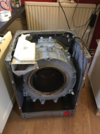Had this machine an awful long time. A few electronic issues in that time, but this is the first mechanical problem....
Filled it up with a pile of washing, it filled with water, then it attempted to rotate the drum but couldn't, so went to fault. Took the washing out, tried to spin the drum round and it was quite tight, but movable. Removed the drive belt, worked it back and forth a few times, there was a light tinkle noise, but eventually the drag on the drum- what ever it was cleared. Drum bearing seemed OK, no noise, no play, so I put it all back together and ran a fast spin, completely empty which worked fine.
Now to try it with another wash. [EDIT] No problem at all, it did that wash and a second one after it.
How do the manufacturers get away with leaving such razor sharp edges on these machine panels? Blood every where.
Filled it up with a pile of washing, it filled with water, then it attempted to rotate the drum but couldn't, so went to fault. Took the washing out, tried to spin the drum round and it was quite tight, but movable. Removed the drive belt, worked it back and forth a few times, there was a light tinkle noise, but eventually the drag on the drum- what ever it was cleared. Drum bearing seemed OK, no noise, no play, so I put it all back together and ran a fast spin, completely empty which worked fine.
Now to try it with another wash. [EDIT] No problem at all, it did that wash and a second one after it.
How do the manufacturers get away with leaving such razor sharp edges on these machine panels? Blood every where.
Last edited:


